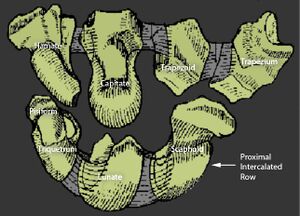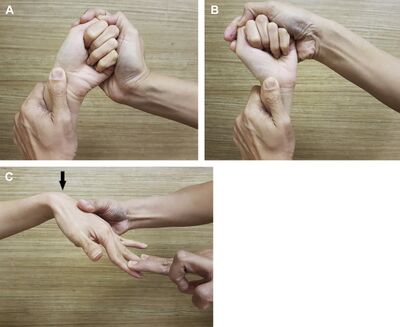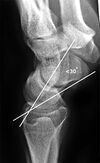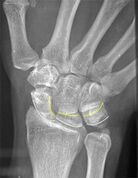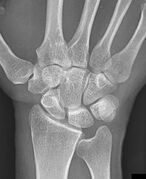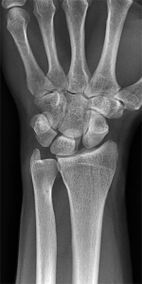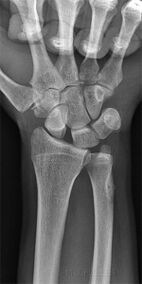Carpal Instability
There are eight carpal bones of the wrist ("carpus") which are held together by ligaments. With ligamentous injury the wrist can become unstable and lead to post-traumatic osteoarthritis.
Anatomy
The carpal bones give stability to the wrist in various positions. The lunate plays a key role in carpal stability.
Bone Alignment
There are two rows and three columns. The bones are intercalated meaning that they are tightly tethered to each other (figure 1).
The two rows are termed proximal and distal. The proximal rows consist of the scaphoid, lunate, triquetrum, and pisiform. The distal row consists of the trapezium, trapezoid, capitate, and hamate. The proximal row articulates with the distal radius, while the distal row articulates with the metacarpal bones.
The scaphoid acts as a bridging bone and translates some of the movements from the proximal to distal row in giving more stability to radial and ulnar deviations.. There is motion within and between rows.
There are three columns. On the radial side is the lateral column and this contains the scaphoid, trapezoid, and trapezium; it provides longitudinal stability. On the ulnar side is the medial column and this contains the triquetrum and provides rotational stability. The lateral and medial columns move to accommodate ulnar and radial deviation. The central column contains the lunate, capitate, and hamate; it doesn't deviate a lot, rather there is movement around it.
The centre of rotation happens through the lunocapitate joint. The radial column takes about 75% of load, while the ulnar column takes about 25% of load.
Radial and Ulnar Deviation
Radial deviation: the scaphoid flexes forcing the lunate into palmar flexion, the hamate rotates into "high" position.
Ulnar deviation: scaphoid extends (it fills the anatomical snuff box) pulling the lunate into dorsiflexion hamate rotates into "low" position.
Ligaments
The bones have a complex geometry that allows them to remain in content with movement. However there is little bony congruity and with that there is less inherent stability. There is a network of ligaments that hold the bones in their correct positions. The ligaments are categorised as intrinsic (carpal to carpal) and extrinsic (radius or ulna to carpal).
Intrinsic Ligaments
The interosseous ligaments connect the carpal bones.
- ScaphoLunate ligament (SLL). Three portions, dorsal is the strongest, the proximal/membranous is associated with the capsule, and the palmar.
- LunoTriquetral ligament (LTL)
- ScaphoTrapezioTrapezoid ligament (STT)
Extrinsic Ligaments
The extrinsic ligaments connect the radius to the carpus.
- Volar RadioScaphoCapitate ligament
- Volar RadioLunoTriquetral ligament
- Volar UlnoLunate
- Volar UlnoTriquetral
- Volar RadioUlnar
- Dorsal RadioTriquetral
- Dorsal RadioUlnar
TFCC
Thumb Ligaments
- Superficial Anterior Oblique Ligament
- Deep Anterior Oblique Ligament
- Dorsal Radial Ligament
Classification
There are 6 major categories to consider when analysing carpal instability, covering chronicity, constancy, aetiology, location, direction, and pattern.
| Category I—Chronicity | Category II—Constancy | Category III—Aetiology | Category IV—Location | Category V—Direction | Category VI—Pattern |
|---|---|---|---|---|---|
| Acute, <1 wk (maximum healing potential) | Predynamic | Congenital | Radiocarpal | VISI | CID |
| Dynamic | Traumatic | Intercarpal | DISI | CIND | |
| Subacute, 1–6 wk (some healing potential) | Inflammatory | Midcarpal | Ulnar | CIC | |
| Arthritis
Neoplastic |
Carpometacarpal | Radial | CIA | ||
| Chronic, >6 wk (poor healing potential) | Iatrogenic | Specific bones/ligaments | Ventral | ||
| Miscellaneous | Rotatory |
Constancy
The deformity can be dynamic or static. This is why it is important to take loading radiograph views (clenched fist, radial and ulnar deviation). A static MRI can incorrectly grade an injury without these dynamic x-ray views.
Aetiology
- Trauma, usually a fall onto an outstretched hand with rotation of the forearm on the planted hand.
- Sequelae of trauma
- Degenerative
- Secondary for example osteonecrosis
Direction of Instability
The lunate is in a state of dynamic balance. As long as the scapholunate and lunotriquetral ligaments are intact, and there are no other problems in the distal radius, the lunate sits in the middle and doesn't move in a dorsal or volar direction. All the forces are balanced.
When the scaphoid flexes it tries to pull the lunate towards the volar side. When this happens the lunotriquetral joint on the other side stops it from going down. The triquetrum tries to extend to keep the lunate in a balanced position.
When a carpal ligament is disrupted, the bones don't move in their normal concerted fashion, leading to abnormal bone positions and contact points, and overloading of the joint surfaces. Carpal instability can be defined as the inability of the wrist to maintain a normal balance between the articulating surfaces under physiologic loads (dyskinetics) and/or movements (dyskinematics)
For DISI and VISI injuries the lunate follows the unbalanced force. DISI refers to dorsal intercalated segmental instability in which the scapholunate ligament is injured. VISI refers to volar intercalated segment instability where the lunotriquetral ligament is injured. The name refers to the abnormal position of the carpal bones due to abnormal tethering. A third pattern is perilunate dislocation, which is one of the most severe forms of carpal instability where multiple intrinsic and extrinsic ligaments are torn and the lunate completely dissociates from the other carpal bones. Due to the high energy associated with this injury, there may be associated neurovascular injury. See video.
If the scapholunate instability is not addressed then there can be progression to scapholunate advanced collapse (SLAC). The degenerative change starts in the radioscaphoid joint, and spreads with the lunate fossa being the last one to be affected.
Pattern of Instability
Carpal instability is called dissociative if it is happening in between the carpal bones in the same row. It is called non-dissociative when it is happening between the two rows. If it is affecting both rows and the columns it is called complex. If it is happening due to non-carpal problems it is called adaptive. CI stands for carpal instability.
- Carpal Instability Dissociative (CID): Instability exists between carpal bones of a single row. This category includes VISI, DISI, and scaphoid fractures.
- Carpal Instability Non-dissociative (CIND): Instability exists between rows either at the radiocarpal joint (e.g. radiocarpal fracture dislocations), or midcarpal joint (e.g. midcarpal instability)
- Carpal Instability Complex (CIC): Features of both CID and CIND. Includes perilunate dislocation.
- Carpal Instability Adaptive (CIA): Refers to carpal malalignment as a result of adaption to extracarpal changes such as instability caused by distal radius malunion or Madelung deformity.
CID predominantly happens in the proximal row. It can happen in the distal row but it is very rare. DISI is more common than VISI. DISI stands for dorsal intercalated segment instability, is due to scapholunate ligament instability, and the scapholunate angle is increased.
Epidemiology
Injury usually occurs in young and middle aged individuals.
In a series of 535 patients with wrist pain of unknown origin who underwent dynamic radiography, scapholunate dissociation was present in 5.8%, DISI in 2.2%, VISI in 1.7%, with a total prevalence of carpal instability of 9.7%.[2]
Carpal instability is present in 30% of patients with displaced intra-articular radius or scaphoid fractures, but the diagnosis is often missed.
Clinical Features
- High energy trauma
- Displaced, intra-articular distal radius fracture, especially with persistent wrist pain despite fracture fixation.
- Sudden onset of neurological symptoms suggesting acute median nerve compression
History
The most common injury mechanism is a fall on an outstretched hand with an extended wrist. High energy trauma such as with contact sport or motorcycle accidents are other causes. Delayed presentations are not uncommon.
The main presenting complaint is pain, typically over the dorsum and dorso-radial aspect of the wrist which is aggravated by loading the extended wrist or with strenuous activity.
Patients may also describe clicking, weakness, and reduced range of motion.
Examination
The main physical findings are swelling, reduced range of motion, and localised tenderness. In extreme cases there may be neuropathies and deformities with a palpable displaced lunate.
The astute examiner with a good knowledge of surface landmarks may find localised tenderness over an area of relevant ligamentous disruption. For scapholunate tenderness, first find the Listers tubercle dorsally and go exactly distal to it. For lunotriquetral tenderness, first find the radioulnar joint, and go just distal to it.
Look for evidence of previous operations. Previous operative history is important, for example a scapholunate disruption could have been missed at the time of a distal radius fracture repair, or there may have been a previous non-union.
The range of motion is usually reduced.
The Watson scaphoid shift test, scapholunate and lunotriquetral ballottement test, and resisted finger extension tests can be performed.
- Watson test: the examiner presses on the scaphoid tuberosity with the patients wrist in slight dorsiflexion. The wrist is passively deviated from an ulnar to radial direction. Pain and clunking signifies a positive test, pain without clunking is a positive modified test. The clunk is a result of subluxation of the proximal scaphoid over the dorsal lip of the radius.
- Lunotriquetral ballottement involves examining for volar-dorsal movement of the triquetral on the lunate.
- Finger extension test: The patient’s wrist is held partially flexed and the index and middle fingers are extended against the examiner’s resisting hand. Pain over the dorsal scapholunate interval is considered a positive test.
Overall clinical examination is insufficient to achieve any measure of diagnostic confidence.
Common Pitfalls
There are no pathognomonic clinical signs of carpal instability, with symptoms and signs often being quite subtle. One pitfall is failure to accurately interpret the history from the patient. The patient may say that they feel like a bone has moved out of their wrist . The examiner then sees a normal x-ray and assumes everything is fine and incorrectly diagnose wrist sprain. The x-ray is normal in 25% of cases of lunate dislocation, and often the x-ray finding are quite subtle.
Associated Injuries
For VISI, once there is a static deformity with a reduction in the SL angle, the dorsal radiocarpal ligament is also injured. Associated injuries are to the TFCC and UT ligaments. This is because if the lunotriquetral ligament is injured, then the force went from the ulnar side, and if the force is great enough to cause damage to the LT ligament then usually there is damage to the TFCC and UT ligaments as well.
Perilunate injuries: occurs with force pushing the wrist into extension and ulnar deviation. Multiple ligamentous injuries are necessary to tear the distal row from the lunate to produce perilunate dislocation.
Mayfield stages
- Usually begins radially and destablises through the body of the scaphoid (without fracture) or through the scapholunate interval (with dissociation)
- The force is transmitted ulnarly through the space of Poirier (between the lunate and capitate volarly)
- Next force transmission disrupts the luno-triquetral articulation.
Imaging
Radiographs
Radiography assesses for static and dynamic carpal instability. The views are:
- AP, lateral, oblique
- Clenched fist
- Radial and ulnar deviation - useful for detecting intrinsic joint issues
The angles are the ScaphoLunate angle, RadioLunate angle, RadioScaphoid angle, and CapitoLunate angle.
The most important angle is the ScaphoLunate angle (figure 3). The most important bone to pay attention to is the lunate. To measure the SL angle, draw a line between the inferior margin of the scaphoid tuberosity and body of the scaphoid, draw another line perpendicular to the lunate. The angle between these is the SL angle. The normal range is 30-60 degrees. Anything less than 30 is called VISI, anything more than 60 is called DISI.
When interpreting the SL angle in static instability, remember that if the carpal bones weren't connected, the scaphoid would flex (move in a volar direction), and the triquetrum would extend (move in a dorsal direction). Therefore when the SL is injured, the uninjured LT ligament drags the lunate into extension (DISI). While when the LT is injured, the intact SL ligament drags the lunate into flexion (VISI).
Partial tears are more difficult to assess in static views, hence the importance of the stress views (figure 5). Static radiographs on their own as signs of carpal instability using dynamic radiography have a sensitivity of 56%, specificity of 96%, and +LR of 15.5.[2]
The CapitoLunate angle is the angle between the long axis of the capitate and the mid axis of the lunate on the sagittal imaging of the wrist. In a normal situation it should be less than 30° in the resting (neutral) position. The angle is increased in carpal instability such as with a dorsal intercalated segment instability and volar intercalated segment instability. The scapholunate angle is used to differentiate between the two.[3]
DISI x-ray findings
- AP View
- Terry Thomas Sign: Scapholunate gap >3mm with clenched fist view on the AP view.
- Cortical ring sign: caused by scaphoid malalignment.
- Humpack deformity: with DISI associated with an unstable scaphoid fracture
- Scaphoid shortening
- Lateral view
- SL angle more than 70 degrees
Other
MRI may be helpful but the sensitivity is only 60-70%.
Arthroscopy is often considered to be the gold standard. However ligamentous injury on arthroscopy has poor correlation with symptoms. Ligamentous interruption is commonly found bilaterally.[4]
Differential Diagnosis
- DeQuervain’s tenosynovitis
- Extensor tendonitis
- Carpal tunnel syndrome
- Distal radioulnar joint instability
- Triangular fibrocartilage complex injury
- Wartenberg syndrome (radial sensory neuritis)
- Intersection syndrome
- Nondisplaced scaphoid fractures
Treatment
Overall there is no high level evidence to guide treatment. Post-traumatic osteoarthritis is an expected outcome in severe or chronic cases.
Partial tears of the scapholunate and lunotriquetral ligaments in the presence of normal x-ray findings are usually treated nonoperatively with immobilisation and rehabilitation. If there is persistent symptoms then wrist arthroscopy is the next step, and if a tear is confirmed then operative debridement and stabilisation can be done.
In complete tears, the initial treatment is operative, and there are a variety of techniques with the aim of restoring and maintaining carpal alignment. Usually screws and pins are used.
In perilunate dislocation initial management may be closed reduction, however often this is not successful. Reduction can be done operatively along with nerve decompression.
See Tan and colleagues for review of the surgical treatment options.[1]
Recommendations
- In acute wrist pain without trauma, there is no need to pursue the diagnosis of carpal instability
- Obtain radiographs with static +/- dynamic views. If dynamic views are not obtained, it is even more important to have a clear follow up plan for return if symptoms do not settle.
Videos
Further Reading
- Carpal instability - OrthoPaedia
- Carpal Instability MRI - Radsource
- Tan and colleagues[1]
References
- ↑ 1.0 1.1 1.2 Tan DMK, Lim JX. Treatment of Carpal Instability and Distal Radioulnar Joint Instability. Clin Plast Surg. 2019 Jul;46(3):451-468. doi: 10.1016/j.cps.2019.03.006. PMID: 31103089.
- ↑ 2.0 2.1 Truong NP, Mann FA, Gilula LA, Kang SW. Wrist instability series: increased yield with clinical-radiologic screening criteria. Radiology. 1994 Aug;192(2):481-4. doi: 10.1148/radiology.192.2.8029419. PMID: 8029419.
- ↑ Capitolunate angle | Radiology Reference Article | Radiopaedia.org
- ↑ Cantor RM, Stern PJ, Wyrick JD, Michaels SE. The relevance of ligament tears or perforations in the diagnosis of wrist pain: an arthrographic study. J Hand Surg Am. 1994 Nov;19(6):945-53. doi: 10.1016/0363-5023(94)90094-9. PMID: 7876493.
Literature Review
- Reviews from the last 7 years: review articles, free review articles, systematic reviews, meta-analyses, NCBI Bookshelf
- Articles from all years: PubMed search, Google Scholar search.
- TRIP Database: clinical publications about evidence-based medicine.
- Other Wikis: Radiopaedia, Wikipedia Search, Wikipedia I Feel Lucky, Orthobullets,
